Knh 184 - Study guides, Class notes & Summaries
Looking for the best study guides, study notes and summaries about Knh 184? On this page you'll find 19 study documents about Knh 184.
All 19 results
Sort by
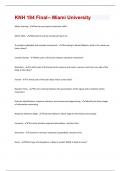
-
KNH 184 Final-- Miami University | 60 Questions and Answers(A+ Solution guide)
- Exam (elaborations) • 6 pages • 2023
-
- $3.49
- 2x sold
- + learn more
Motor learning - How do we acquire movement skills? Motor Skills - Movements are the component parts of... To produce adaptable and complex movements - According to Daniel Wolpert, what is the reason we have a brain? Cerebral Cortex - Which part of the brain initiates voluntary movement? Brainstem - In which part of the brain do the sensory and motor neurons cross from one side of the body to the other? Frontal - In which part of the brain does motor cortex exist? Reaction Time - The tim...
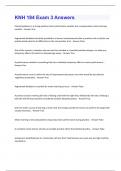
-
KNH 184 Exam 3 Questions & Answers Solved 100% Correct!!
- Exam (elaborations) • 11 pages • 2024
- Available in package deal
-
- $7.99
- + learn more
Physical guidance is a strong positive motor performance variable, but a weak positive motor learning variable. - Answer-True Augmented feedback should be provided to a learner instantaneously after a practice trial so she/he can quickly decide what to do differently on the next practice trial. - Answer-False One of the reasons a retention interval must be included in a transfer/retention design is to allow any temporary effects of practice to dissipate (go away). - Answer-True A performan...
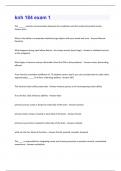
-
knh 184 exam 1 Questions with well explained answers
- Exam (elaborations) • 10 pages • 2024
- Available in package deal
-
- $7.99
- + learn more
The ______ controls communication between the cerebellum and the cerebrum/cerebral cortex - Answer-pons What is the ability to manipulate relatively large objects with your hands and arms - Answer-Manual Dexterity What happens during rapid elbow flexion.. the triceps muscle (two things) - Answer-is inhibited and acts as the antagonist What types of neurons convey information from the CNS to the periphery? - Answer-motor, descending, efferent If you found a correlation coefficient of .75 ...
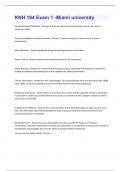
-
KNH 184 Exam 1 -Miami university Questions with 100% Correct Answers | Verified
- Exam (elaborations) • 16 pages • 2024
- Available in package deal
-
- $7.99
- + learn more
Two fundamental Questions - Answer-How do we acquire movement skills? How do we control movement skills? Three sub disciplines of motor behavior - Answer-1) motor learning 2) motor control 3) motor development Motor Behavior - Answer-people do things by exerting muscular contractions Motor Control - Answer-examines the control mechanisms for movement Motor learning - Answer-set of internal and mental processes associated with practice or experience leading to relatively permanent gains in...
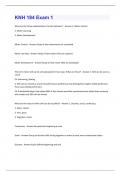
-
KNH 184 Exam 1 Questions & Answers Solved 100% Correct!!
- Exam (elaborations) • 8 pages • 2024
- Available in package deal
-
- $7.99
- + learn more
What are the three subdisciplines of motor behavior? - Answer-1. Motor Control 2. Motor Learning 3. Motor Development Motor Control - Answer-Study of how movements are controlled Motor Learning - Answer-Study of how motor skills are acquired Motor Development - Answer-Study of how motor skills are developed The term motor skill can be conceptualized in two ways. What are those? - Answer-1. Skill can be seen as a task EX: Swimming, Skating 2. Skill can be viewed as a level of performance...
KNH 184 Exam Bundle
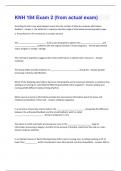
-
KNH 184 Exam 2 (from actual exam)All Possible Questions and Answers with complete solution
- Exam (elaborations) • 6 pages • 2024
- Available in package deal
-
- $7.99
- + learn more
According to Hick's Law, what happens every time the number of stimulus-response alternatives doubles? - Answer-1. the performer's response selection stage of information processing takes longer 2. the performer's RT increases by a constant amount The _________________________ theory was developed to address the ___________________ and ____________________ problems with the original concept of motor programs. - Answer-generalized motor program / novelty / storage The inverted-U hypothes...
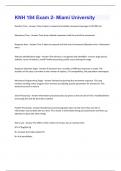
-
KNH 184 Exam 2- Miami University Questions With Complete Solutions, Graded A+
- Exam (elaborations) • 7 pages • 2024
- Available in package deal
-
- $7.99
- + learn more
Reaction Time - Answer-Time it takes to respond and initiate movement (average is 120-280 ms) Movement Time - Answer-Time from initiated movement until the end of the movement Response time - Answer-Time it takes to respond until the end of movement (Reaction time + Movement time) Stimulus Identification Stage - Answer-The stimulus is recognized and identified-- sensory stage (vision, audition, touch, kinethesis, smell) Parallel processing usually occurs during this stage Response Selectio...
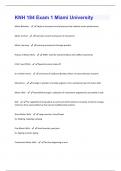
-
KNH 184 Exam 1 Miami University Questions & Answers Solved 100% Correct!!
- Exam (elaborations) • 6 pages • 2024
- Available in package deal
-
- $7.99
- + learn more
Motor Behavior - Study of movement and processes that underlie motor performance Motor Control - Examines control mechanism of movement Motor Learning - Learning movements through practice History of Motor Skills - WWII- need for trained military with skillful movements Fritts' Law (1954) - Speed accuracy trade-off Dr. Franklin Henry - University of California Berkley, Father of motor behavior research Movement - Change in position of a body segment. Are a component part of motor skills ...
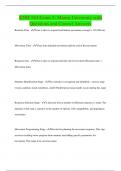
-
KNH 184 Exam 2- Miami University with Questions and Correct Answers
- Exam (elaborations) • 11 pages • 2024
-
- $9.99
- + learn more
Reaction Time - Time it takes to respond and initiate movement (average is 120-280 ms) Movement Time - Time from initiated movement until the end of the movement Response time - Time it takes to respond until the end of movement (Reaction time + Movement time) Stimulus Identification Stage - The stimulus is recognized and identified-- sensory stage (vision, audition, touch, kinethesis, smell) Parallel processing usually occurs during this stage

How did he do that? By selling his study resources on Stuvia. Try it yourself! Discover all about earning on Stuvia


